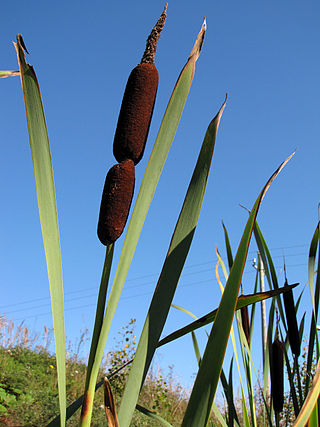
The Typhaceae are a family of flowering plants, sometimes called the cattail family. The botanical name for the family has been recognized by most taxonomists.

Toxicoscordion venenosum, with the common names death camas and meadow death camas, is a species of flowering plant in the family Melanthiaceae. It is named for its well known toxic qualities, with both its common names and its scientific name referencing this. Because its nectar is also poisonous, it is mainly pollinated by the death camas miner bee, which specializes in collecting the toxic pollen for its young. It is native to western North America from New Mexico to Saskatchewan and west to the Pacific Ocean.

Sparganium (bur-reed) is a genus of flowering plants, described as a genus by Linnaeus in 1753. It is widespread in wet areas in temperate regions of both the Northern and Southern Hemispheres. The plants are perennial marsh plants that can grow to 3.5 m, with epicene flowers.

Sparganiaceae is a family of flowering plants. Such a family was previously recognized by most taxonomists.

Xerophyllum is a genus of perennial plants from the family Melanthiaceae. The genus is native to North America.
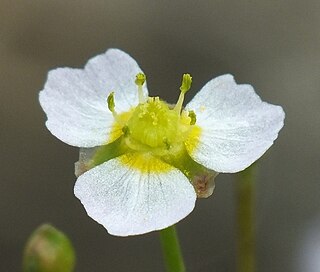
Alisma gramineum is a small aquatic plant in the water-plantain family. It has several common names including narrowleaf water-plantain, ribbonleaf water-plantain or ribbon-leaved water-plantain, and grass-leaved water-plantain. It grows in mud or submerged in shallow fresh or brackish water in marshy areas.

Sparganium natans is a species of bur-reed known by the common names least bur-reed and small bur-reed. It is a water circumboreal plant inhabiting North America, Europe, West Asia and Japan. It is usually found submersed in shallow, calm water. This bur-reed has thin, flexible, grasslike leaves which float in the water. Plants that spend more time out of water at the waterline are tougher and have shorter leaves. The plant bears two inflorescences, the staminate type being a rounded white filamentous ball and the pistillate type a sphere of thick, green, pointy peduncles. The fruits are small green or brown achenes.

Oxygonum is a genus of plants in the family Polygonaceae with about 30 species. It is native to eastern parts of Africa and to the Arabian Peninsula.

Sparganium eurycarpum is a species of bur-reed known by the common names broadfruit bur-reed and giant bur-reed. It is native to wetlands in Eurasia and North America. It is a clonal perennial, spreading by below-ground rhizomes. The common name, bur-reed, arises from the distinctive round clusters of fruits that take the form of a mace. It can be distinguished from all other species of bur-reed by the presence of two stigmas.

Stenanthium is a North American genus of flowering plants in the tribe Melanthieae of the family Melanthiaceae.
Branched bur-reed is a common name for several plants in the genus Sparganium and may refer to:
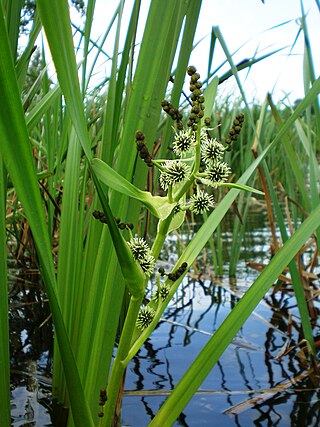
Sparganium erectum, the simplestem bur-reed or branched bur-reed, is a perennial plant species in the genus Sparganium.

Sparganium angustifolium is a species of flowering plant in the cat-tail family known by the common names floating bur-reed and narrowleaf bur-reed. It has a circumboreal distribution, occurring throughout the northern latitudes of the Northern Hemisphere. It is an aquatic plant, growing in water up to 2.5 meters deep. Its habitat includes acidic, low-nutrient freshwater bodies such as ponds, lakes, slow-moving streams, and ditches. It can become abundant, practically covering the surface of the water. It is a perennial herb producing a floating stem with long, narrow, flattened leaves which can be quite long, sometimes reaching over two meters. It is monoecious, individual plants bearing both male and female inflorescences. These are spherical, the male inflorescence a ball of stamens and the female inflorescence a ball of developing fruits.
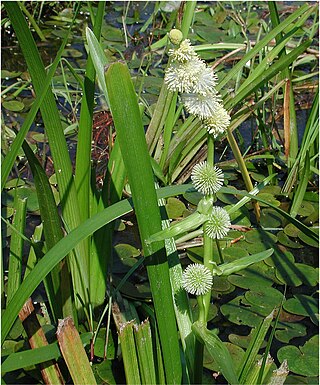
Sparganium emersum is a species of flowering plant in the cat-tail family known by the common names European bur-reed and unbranched bur-reed. It has a circumboreal distribution, occurring throughout the northern latitudes of Eurasia and North America. It is an aquatic plant, growing in shallow water bodies such as ponds and streams. It can become abundant at times. It is a perennial herb producing a floating stem up to 2 meters long. The leaves may be limp and floating or stiff and erect, emerging above the water surface. The leaves are flat and straplike, sometimes with a triangular, keeled base that can help distinguish it from the similar Sparganium angustifolium. It is monoecious, individual plants bearing both male and female inflorescences. These are spherical, the male inflorescence a ball of stamens and the female inflorescence a ball of developing fruits growing beneath the male spheres.

Lake Hüüdre is a lake located in the Otepää Uplands in Jõgehara village, Kanepi Parish, Põlva County, Estonia.
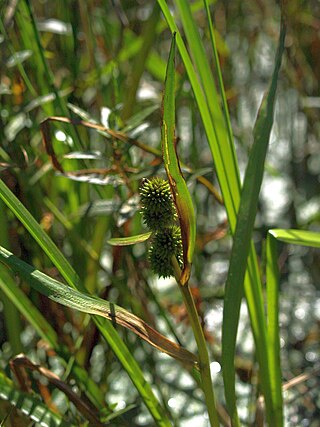
Sparganium glomeratum, the clustered bur-reed, is a species of bur-reed. It is a water plant native to high elevation lakes and marshes of Europe, Asia, and North America. North American populations were doubted as introduced due to its scarce and scattered populations, but a recent herbarium survey found more localities of the species in the central of Canada, concluding the species as circumpolar species.

Sparganium americanum, American bur-reed, is a perennial plant found in the United States of America and Canada. Though this species resembles a grass, it is a type of bur-reed. This species is important for conservation purposes because it has the ability to remove nitrogen and phosphorus runoff from water, like many other wetland species. By doing this, it protects waterways from excess nitrogen which can cause eutrophication. This increased nitrogen is especially a problem during the farmers’ growing season. During this same time frame the S. americanum is growing and taking up nitrogen.

Hypericum gramineum, commonly known as small St. John's wort or grassy St. Johnswort, is species of flowering plant in the St. Johns wort family Hypericaceae. It is found in parts of Southeast Asia, Oceania, and the Pacific.
Sparganium acaule is a perennial plant found in the United States of America and Canada. This taxon was included within Sparganium emersum by Cook and Nicholls (1986) but was recently resurrected as a distinct species.

Murdannia graminea is a species of flowering plant commonly known as grass lily, in the family Commelinaceae. It is an upright perennial herb with mauve to purple flowers and grows in New South Wales, Queensland, Western Australia and the Northern Territory.

















